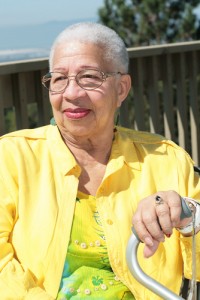Person-Centered Practices and Aging: Eveleth
EXAMPLE: Eveleth’s Story
 Eveleth lived in her own apartment in downtown St. Paul and had a great circle of friends. She was very independent in going where she wanted. She developed some severe health problems, and needed to go to a nursing home. When she was ready to leave, the nursing home offered her some alternatives of where to go. Most were apartment complexes in the suburbs, rather than where she wanted to live. She stayed in the nursing home for months without being able to leave.
Eveleth lived in her own apartment in downtown St. Paul and had a great circle of friends. She was very independent in going where she wanted. She developed some severe health problems, and needed to go to a nursing home. When she was ready to leave, the nursing home offered her some alternatives of where to go. Most were apartment complexes in the suburbs, rather than where she wanted to live. She stayed in the nursing home for months without being able to leave.
Several of Eveleth’s friends attended a Person-Centered Planning training. They did not know about her situation. When they found out about the situation, they helped Eveleth by sharing information about resources in St. Paul and assisted her in finding an apartment in the downtown area.
EXAMPLE: Using Personal Futures Planning as a Parent Ages
 I want to tell a very personal story. It shows how Personal Futures Planning can be used effectively with many different age groups, types and severities of disabilities, and systems. My father experienced a stroke two years ago. He was invited to attend a Personal Futures Plan. I hope to illustrate how Futures Planning was successfully used to support an aging person to have a dream for the future and do what is necessary to realize that dream.
I want to tell a very personal story. It shows how Personal Futures Planning can be used effectively with many different age groups, types and severities of disabilities, and systems. My father experienced a stroke two years ago. He was invited to attend a Personal Futures Plan. I hope to illustrate how Futures Planning was successfully used to support an aging person to have a dream for the future and do what is necessary to realize that dream.
My father was 75 years old when he suffered a stroke. Even though it was not life threatening, we knew that his life changed forever. So also were the lives of all of us who love him so much.
I talked with my father and other members of the family to see how everyone felt about doing a Personal Futures Plan. This is a form of person-centered planning. Everyone agreed that this might be a way to resolve some of the problems confronting us all as a result of Dad’s stroke. So the process of creating some new visions for his future began.
Right away, we ran into two common challenges when doing futures planning: locating a facilitator and arranging for the planning meetings. We were working within a tight time frame. My sister and her husband were coming from Colorado for a long holiday weekend. They would only be here for a few days, and we scheduled the meetings during their visit. I decided to be the facilitator for my father’s plan.
The whole family gathered. My father and mother attended, along with my two sisters and one brother. Their spouses and children all participated. We began with a common activity in our family – an informal dinner.
We remained true to the Personal Futures Planning process. We included the same tools and asked the same questions as if the plan were developed for a person with any disability. We used the process to discover my father’s gifts and capacities. We created not only a vision for a better future for him but also a plan for the rest of the family.
One of the first things we realized while doing the history is that each of us remembered things differently. We felt that this allowed us to see a more full, complete picture of our parents. We also discovered that some of us didn’t want to admit that anything had really happened. Our family was fortunate that one of my sisters is a rehabilitation specialist. She was able to translate the medical reports for us. My other sister is a speech pathologist. She was able to contribute to our awareness of our father’s disabilities.
We also made a surprising discovery during the meeting. Although we consider ourselves a close family, no one had the telephone numbers of everyone who would need to be notified in the event of another family medical emergency. We organized telephone numbers and made a record of our parent’s medical identification numbers.
Dad was very specific about his vision for the future. He had many ideas about how his family, friends, neighbors and the system could support him with dignity and without taking away his independence. His vision for the future included having quality time with his family. He wanted to continue living in his own home. He wanted to have as much independence as possible in all aspects of his life. He wanted as much support as necessary to achieve his dreams.
When the initial planning meeting was over we had identified goals. These would begin movement toward the vision. Members of the planning group committed to perform tasks that support the vision in many ways. We left with a renewed sense of the value of life and a shared vision of a better future for my father.
Since the initial meeting, the vision has not changed. However, some new methods for supporting the vision have developed. For example, Mom mentioned that she had trouble sleeping because she was afraid that something might happen to Dad during the night. We solved the problem by having grandchildren take turns spending the night. This solution worked well for everyone.
Personal Futures Planning continues to be a process with many ups and a few downs. I am proud to have learned the skills of facilitating this process. It gives us permission to dream while learning to problem-solve. We have learned it is okay to be upset with the system and even with each other. But most of all, we have learned how my father’s vision for his future and our support of that vision allow him to enjoy his life to its fullest.

